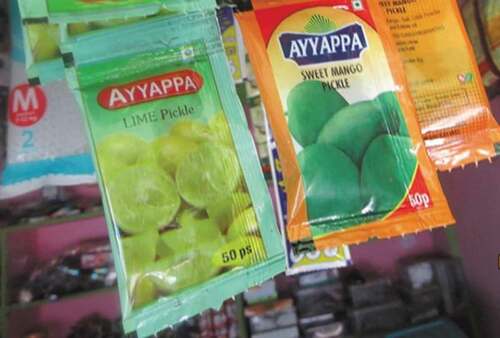ABSTRACT
India is experiencing a nutrition transition, with sales of packaged and processed foods rapidly increasing in recent years. This study sought to understand the views and experiences of self-help groups about highly processed, packaged food in Visakhapatnam, India, using the Photovoice method. Participants were able to record, reflect on and critique their environments through participatory analysis, identifying key themes, and offering a critical lens on their food environment and experiences. On an average eight and 14 members participated in the Photovoice workshops held in urban and rural Visakhapatnam respectively. The key themes emerging from the photos and text data are that participants experienced highly processed packaged foods as being: 1) democratic (easily available and consumed by all, affordable and accessible; 2) convenient (easy to prepare) and 3) unhealthy (for human consumption and for environmental sustainability). These data demonstrate the challenges facing public health nutritionists in wishing to shift dietary behaviors to healthy habits: on the surface participants acknowledged their unhealthy characteristics, however these products may now be embedded in dietary culture. Traditional methods for changing dietary habits may not be able to capture the complexity and systems approach is required to explore the most effective entry points for affecting change.
Introduction
Calls for concern over the health impact of highly processed food consumption in India are driven by the recent increases in the prevalence of type 2 diabetes and obesity (Deepa, Anjana, and Mohan Citation2017; Geldsetzer et al. Citation2018; Luhar et al. Citation2018; Thow et al. Citation2016). India is one of many countries to have been experiencing a nutrition transition, a shift away from the traditional and healthy diet of legumes, vegetables and whole grains, toward a diet gradually replaced by more animal sourced proteins, fats and oils, sugar sweetened beverages, and generally more highly processed foods (Deepa, Anjana, and Mohan Citation2017; Gulati and Misra Citation2014; Misra et al. Citation2011; Popkin, Adair, and Ng Citation2012).
In their analysis of purchase trends of processed foods in urban India, Law et al. Citation2019 report that sales of packaged and processed foods have nearly doubled from 2012 to 2018, noting that the reasons behind such trends are complex (Euromonitor Citation2019; Law et al. Citation2019). Key culprits identified were globalization, with the associated increase in trade and economic growth, and change in lifestyles. However, the way in which shifting lifestyles are embedded into the cultural norms is also an important factor to understand.
The fact that highly processed, packaged foods are easily accessible, affordable, and very quick to prepare has helped to establish them in every day dietary choices. Research into the cultural factors embedding packaged processed foods into diet is central to understanding these trends (Shaikh et al. Citation2017). Sociologist Baviskar hypothesizes that highly processed foods have become “the lowest common denominator in diets across classes and regions in India … […], distinctive in that they appear neutral, floating above older classificatory schemes, tethered only to modernity” (Baviskar Citation2018).
In the context of SHEFS (Sustainable & Healthy Food Systems), a global research programme aiming to generate novel approaches to understand how food systems can deliver nutritious and environmentally sustainable foods, this study sought to capture community members’ views about highly processed, packaged food consumption in Visakhapatnam, India, using Photovoice. Specifically, this study aimed to engage women from self-help groups in both urban and rural settings to record and reflect on benefits and concerns they might have regarding ‘highly processed packaged foods,’ defined as highly or ultra-processed food products (Monteiro et al. Citation2013) which have been packaged for shelf life and rapid consumption, and include “ready-to-eat” products such as chips, noodles, snacks, instant soups, packaged breads, puffs, biscuits, cakes, pastries etc. (Poti et al. Citation2016).
Materials and methods
Photovoice method and theoretical grounding
We used the Photovoice method to collect data in urban and rural areas of Visakhapatnam district located in the southern region of India. We chose Visakhapatnam because the SHEFS India research partner had been working there since 2013 implementing a diabetes and hypertension prevention and management programme in a population of ~200,000 (Mohan et al. Citation2018).
Photovoice is aligned with a Community-Based Participatory Research approach to engage community members to capture their views about an issue through photographs they take themselves (Wang and Burris Citation1997). It is an instrument employed to ensure community voices are incorporated into the research and decision-making processes that affect them. Photovoice is grounded in Paolo Freire’s approach to education for critical consciousness, where participants determine what to represent in a photograph, becoming ‘interpreters of the world’ (Freire Citation1973). This process is strengthened by collective discussions, where people share the meanings of their photographs and reflect on their community. Photographs and accompanying captions have been used as an advocacy tool to bring participants’ voices to the attention of decision makers. Photovoice is at its essence a participatory instrument, either for research or for advocacy and engagement. This orientation of research values collaboration between community members and institutional partners, where decision making is a shared action throughout the research process (Jacquez, Vaughn, and Wagner Citation2013).
Research setting and participants
The research team worked with Self-Help Groups (SHG) in ward number 17 in urban Visakhapatnam and Gunupudi village in rural Visakhapatnam. SHG are voluntary local women’s groups involved in a range of economic, social and community leadership initiatives across India (Kumar et al. Citation2019). SHG have traditionally been involved in supporting community health and nutrition in a range of ways, including engagement in agriculture and advocacy for government programmes focused on nutrition (Kumar and Quisumbing Citation2018). Typically, a SHG has between 8 and 12 members who are engaged in some income-generating activity and are supported through loans from the state government. This includes raising awareness about health issues through the formation of Mahila Arogya Samitis (Women Health Committees).(Induction module for Mahila Arogya Samiti (MAS) Citation2017)
Participatory approach
In this study we characterize the levels of participation of the SHG according to stages of research, namely (1) inputting into the research through formal or informal groups; (2) identifying priorities, goals, and research questions (3) conducting the research, (4) participating in data interpretation; and (5) participating in dissemination of the research findings (Israel et al. Citation2005).
Input into the research process
The SHG nominated members from their respective groups to attend the workshops. They also decided the date and time of the workshops. With each SHG, we ran one Photovoice session consisting of a series of five workshops. These workshops entailed briefing them about the SHEFS project, explaining what Photovoice is, discussing issues around ethics, including consent for participation, consent from those who are pictured and consent to use the photographs that they have clicked for research and dissemination purposes. SHG members also learned to handle a digital camera. We obtained ethics approval for the study from the London School of Hygiene & Tropical Medicine Ethics Committee, UK in Sep 2018 (LSHTM ethics reference: 14664) and the institutional ethics committee of the Centre for Chronic Disease Control, India in March 2019 (CCDC reference IEC_02_2019).
Identifying priorities
Participants went through a process of prioritizing the food items based on what they think is important as a group and their interest to work with that particular food group for Photovoice. Each team prioritized the food items separately and then discussed with the other team why they ranked the food groups the way they did. After comparing the rankings, the group as a whole discussed the priorities and came up with a final ranking. The top-ranked food item was chosen as the food on which they would focus. One of the priorities was processed packaged foods.
Collecting data
Participants were given a period of seven days to take pictures of processed packaged foods of interest, in terms of their interpretation of either the nutritional and/or environmental impact. Participants gathered to discuss the photographic data they had collected. The pictures were projected on the screen and the facilitator led the discussion on the pictures using the SHOWeD concepts – What do you See? What is Happening? How does this relate to Our life? Why does this concern us? and What can we Do about it? (Gant et al. Citation2009). Participants were asked to provide captions to the pictures that they took. They were shown examples of similar work carried out in the UK and also by members in the previous sessions.
Interpretation and analysis of photos and text
Participants were asked to explain why they took the picture and what message they wanted to convey through the picture. Each individual was given the opportunity to present a photograph and explain its significance (Onwuegbuzie et al. Citation2009). The resulting descriptions and group discussion was recorded and transcribed for analysis. The researchers analyzed both photographic data (participants’ voice) and narrative data (discussion data) based on both participants’ and researchers’ understanding to generate the most credible visual and narrative explanation (Tsang Citation2020).
Taking an interpretivist approach, data were analyzed with respect to the meaning people attach to their experiences of the issue in question, in this case packaged processed food (Green and Thorogood Citation2013), focusing on the key themes, the most noteworthy quotes, and any unexpected findings (Breen Citation2006). As such, analysis of the transcripts and photographs was conducted in parallel, with iterative cross-referencing of emerging themes. Thematic analysis of the transcripts identified themes and sub-themes from data (Miles and Huberman Citation1994). Codes were applied to the transcripts based on the broad topic of highly processed foods and then iteratively refined and categorized (Ronzi et al. Citation2016).
Dissemination of the research findings
At the end of captioning, members were asked for a date and time to hold an exhibition of the pictures in their community and were asked to invite other members of the SHG, family, neighbors, friends, and community leaders.
Results
The Photovoice workshops were conducted between November 15, 2019 to December 16, 2019 in urban Visakhapatnam and between January 22, 2020 to February 6, 2020 in rural Visakhapatnam. On an average, eight members participated in the workshops held in urban Visakhapatnam and 14 members in rural Visakhapatnam. A total of 38 photographs were taken and captioned by the participants – 21 in urban Visakhapatnam and 17 in rural Visakhapatnam. Two exhibitions were subsequently held to display the photos with captions which were attended by the community members and leaders. The discussions at these workshops were recorded, translated, transcribed, and then analyzed.
Key thematic categories emerging from the photos and text data are that participants experienced highly processed packaged foods as being: 1) democratic, 2) convenient and 3) unhealthy.
Democratic: “It does not matter if they are rich or poor. Everyone is using them”
The first thematic category is referred to as ‘democratic,’ in that products were reported as being available and consumed by all, affordable, and easily accessible.
Participants were unanimous in their experience that processed packaged foods are “available everywhere.” As described by one participant, “they are present in the shops right next to our houses. There is a shop in every street. We do not have to go far. We can buy these in those stores.” They also experienced that these products cross class boundaries, stating that “it does not matter if they are rich or poor. Everyone is using them.”
As illustrated by the caption for , part of the explanation for participants’ view that these foods are available to everyone had to do with the reported affordability of these products.
Figure 1. “Children and adults like the cream bun. It is not expensive and tasty. People who cannot prepare breakfast at home use this as readymade food.” (Urban)
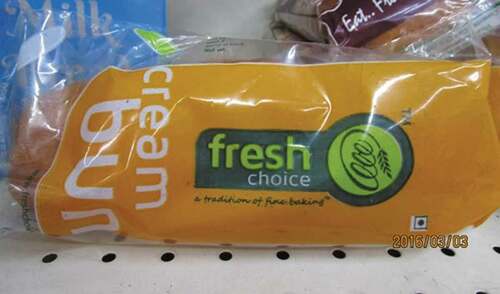
Another participant reported that a packet of corn puffs “[…] are just five rupees or ten rupees we can afford them every day.”
Another frequently discussed issue was the accessibility of packaged processed foods, for example as explained by one participant: “yes, we can get a pizza without any effort, without going there. Now, everything is delivered home. […] With apps like Swiggy, everything is delivered to your doorstep. There are ads of pizza, biryani etc. We can just go downstairs and collect it.”
Convenient: “No one is ready to use […] physical labor”
The second thematic category is referred to as ‘convenient.’ Here, participants reported products as being easy to prepare, with a clear indication that for many there is no going back to past cooking practices. In , the participant is describing instant noodles, and the ease of preparation was an often-mentioned factor in making these products appealing: “After the water is drained, masala is sprinkled, and some vegetables are added. It is very easy. It is very easy. It is an easy process.” Another had the same experience with instant noodles, explaining that: “this is not much labor, sir. There is no difficulty in it. This is just boiled in hot water and taken out. That is just two minutes. […] That is the reason we are doing it.”
Figure 2. “You can prepare this instantly in two-minutes. This can also instantly affect your health adversely. Everyone in my home likes this.” (Rural)
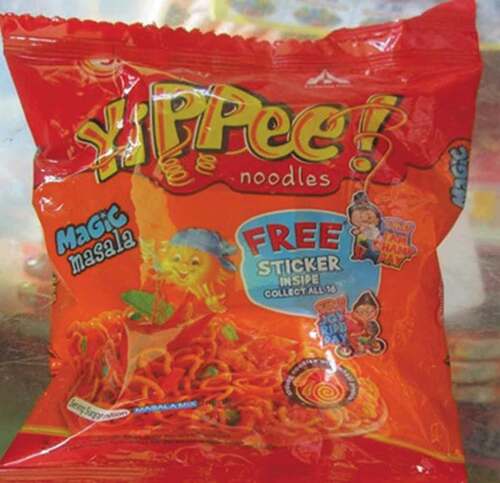
By way of emphasizing the convenience of these pictured snacks, participants offered explanations of how snacks were prepared when they were children themselves, for example “whatever [leftover] broken pearl millet was there, when we used to return from school in the evening, they used to make dosa or pudiyalu … […] That was given to us as snacks. […] Jowar and bajra should be beaten in a mortar. They should also winnow it. No one is ready to use that physical labor. […] I told you about the old woman earlier, she used to place grinding stones in a sheet, and she used to grind the flour using that grinder stone, late into the night until some 12 after the cooking and dinner was over. She used to make snacks out of that broken grains for the next day. No one has the patience for that now.”
However, as illustrated in , there were several instances of contrast between the acknowledgment that processed snacks were advantageous due to their convenience and limited labor required for preparation, yet best not to be consumed, as they were considered unhealthy. One participant reported “they are selling parotas in the supermarkets. We can get tomato or some other pickle. That way you can have a meal in 60 rupees, and you do not have to spend a lot of time as well. In a different case, we should start the cooking from before 2 hours. That is easy.” Yet as illustrated in , the caption suggests that homemade pickles are preferred as they are healthier.
Figure 4. “Snacks prepared at home are healthy. The snacks purchased outside is packed in plastic which is not good for our health and the environment.” (Rural)
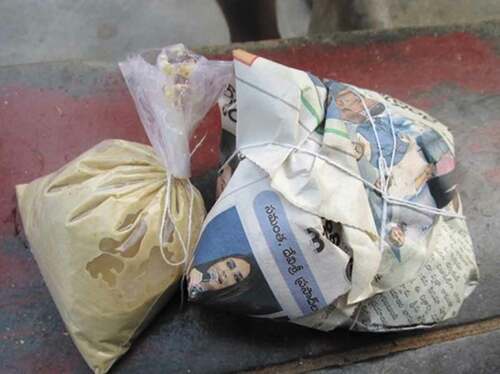
Figure 5. “Homemade food is healthier compared to readymade (ready-to eat) food available in the market” (Urban)
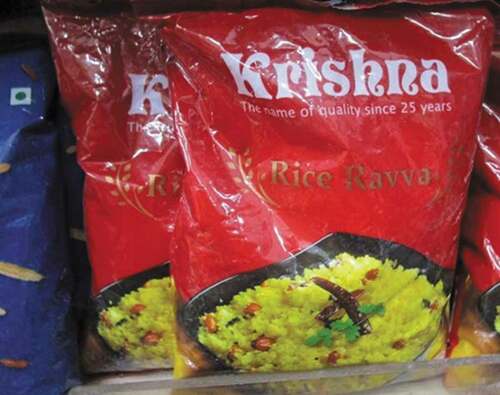
Finally, an additional characterization of these products as being convenient had to do with the packaging, and the option for single portion packets: “Now, you can carry the whole pack with you. [Back] then we used to hold it with our bare hands, or it was […] wrapped in paper.”
Unhealthy: “They eat these because of the peer pressure”
The third thematic category is referred to as ‘unhealthy,’ in that products were reported as being unhealthy for human consumption (despite being tasty), unhealthy for environmental sustainability, and unhealthy in that they are embedded in dietary culture.
The participants made a few mentions of processed foods being unhealthy from a nutritional point of view (as illustrated in ), as well as a food safety point of view, with one participant reporting that “it was said that Maggi are bad for health and it causes stomach pain and there were ads about it.” captures the abovementioned tension between indication that a product is not good for health, and even possibly dangerous (prompting it to be ‘banned,’ caption in ) and yet “people have not stopped using it.”
Figure 6. “You can’t have enough of crispy Jantikalu (locally available savory/snack). But you can’t have it too much. They are prepared using reheated oil and are packed in plastic.” (Rural)

Figure 7. “Children and adults like Maggi and Yippee noodles. This is very affordable, available in small shops. You can prepare this in very short time but not good for health. Even after it was banned, people have not stopped using it. rather the number of companies manufacturing this have increased.” (Rural)
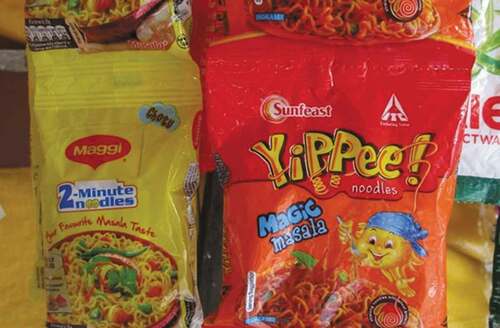
One of the explanations of why consumption of these products is promoted despite health concerns came from a participant outlining the peer pressure experienced by parents and children to consume the processed packaged foods, as opposed to traditional snacks: “There are about 2000 parents in this village, sir. The children of these 2000 parents are studying in that school. There are 10 of us who know this should not be eaten […] These kids look at their peers and say, ‘we want these.’ […] They eat these because of the peer pressure. It is the way today’s society runs.”
Another way in which participants spoke of processed foods as being unhealthy was to do with the impact of the plastic packaging of these products on human health, with one participant explaining that “if food remains in plastic for a longer time without being sold, it is not good for your health. It can badly affect children’s health.”
The impact of plastic packaging on the environment was also discussed at length, as illustrated in the caption accompanying below. There was discussion about increasing use of plastic wrapping, turning into increasing amounts of garbage: “The garbage grows […]. There is garbage all over. There is a lot. Not less people use it. Almost everyone uses it.” Participants reported that plastic stayed in the system “They do not decompose, sir. It takes many years for them to decompose into the soil” with a negative impact on agriculture, where “crops will not grow.”
Figure 8. “Children like these. These are very tasty. But its unhealthy due to plastic packaging. Also, this is not healthy for the environment.” (Rural)
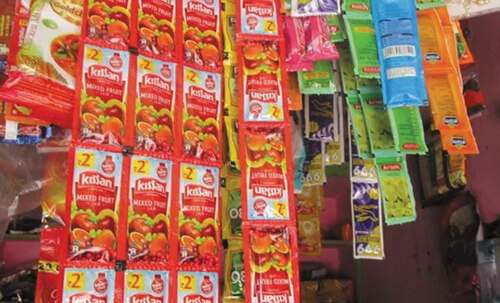
Furthermore, participants explained that it was customary to burn the plastic packaging: “In villages the plastic bags are not thrown into garbage. They throw into the fire that they are cooking.” It was also reported as usual to mix the burnt remains into the soil, with detrimental health impacts and resulting in crops not growing: “in villages, after using the things inside them, plastic milk bags, plastic oil bags, people are not throwing them into garbage. They are burning them. If they are mixed in the soil, seeds do not sprout, or plants do not grow. They should not mix into the soil. I mean, they use garbage as manure, right. They say that they should not be thrown. They say that plants do not grow.” There was acknowledgment that this is harmful to health and the environment, where “smoke could lead to respiratory problems. […] however, “despite all the harm, we choose plastic.”
Discussion
This study sought to capture the views and experiences of self-help groups about highly processed, packaged food consumption in Visakhapatnam, India, using the Photovoice method. The key themes emerging from the photos and text data are that participants experienced highly processed packaged foods as being: 1) democratic 2) convenient and 3) unhealthy.
There were two sets of data: photos, and transcribed discussion about what experiences the photos elicited. Though the same women took and discussed the photos, the messages in the captions and the key themes emerging from the discussion were often markedly different. Captions tended to warn of poor physical and environmental health when consuming the colorful plastic wrapped packets; however, the emphasis during the discussion was on the convenience and appeal of these products, with a clear indication that for many, there is no going back to past cooking practices. In providing captions for the photos, the participants may have felt a certain amount of pressure to ‘say the right thing,’ drawing from health promotion messages. The transcribed discussions possibly reflected the reality of how they felt and how they experienced using these products i.e., relieved at their convenience, supportive of the fact that everyone could purchase them, and willing to purchase them to avoid peer and other societal pressures even though there was acknowledgment that they were not good for human or planetary health.
In many ways these data demonstrate the challenges facing public health nutritionists in wishing to shift dietary behaviors to healthy habits: on the surface participants acknowledged their unhealthy characteristics, however these products may now be embedded in dietary culture. These findings reflect the conclusions of other studies exploring the shifting dietary habits in India. Sharma et al., (Citation2020) report on the high consumption of processed foods in urban and rural households, accounting for approximately 10% of the average total calorie intake in both urban and rural areas of India (Sharma et al. Citation2020). Deepa, Anjana, and Mohan (Citation2017) report that though undeniably healthier, brown rice is now considered less acceptable to most Indians, in part due to its (inconvenient) longer cooking time (Deepa, Anjana, and Mohan Citation2017). Similarly, school children in Delhi report preferring instant noodles to the traditional (and far more nutritious) rajma-chawal (kidney beans and rice) or chhole-chawal (chickpeas and rice) (Shukla Citation2014). Shaikh et al. Citation2017 report that Indian adolescents’ food choices are driven less by healthfulness of food, and rather by taste, convenience, approval from peers as well as perceived modernity, coolness, or prestige (Shaikh et al. Citation2017).
Given the easy availability of these products and preference over healthy foods, policy level interventions are required to raise awareness and regulate the content of processed foods. In this regard, the Food Safety and Standards Authority of India (FSSAI), the prime food regulator, has set a limit of 2% for trans-fat in food products (Business Line Citation2021). These trans-fats are present in processed foods like fried foods, cakes, puffs, pastries etc. Advocacy groups have called upon the ministry of health and FSSAI to adopt the NOVA food classification which categorizes foods into four groups based on the amount of processing the food item undergoes (NDTV Citation2021).
This study illustrates the growing importance of understanding food and diets from a holistic perspective, taking a systems approach to analyze the complexity of the cultural entrenchment of an instant, processed, packaged food (Knai et al. Citation2018a, Citation2018b): focusing on individual behaviors does not address the wider social-cultural and other implications of such foods. A systems approach ensures the identification of key leverage points for change in the systems, rather than only focusing on the individual consumer.
Conclusions
The study highlights the perception of urban and rural communities in India about the processed foods and demonstrates the utility of novel participatory research methods in unraveling these perceptions. The results emphasize the need for changes in the policy to promote a healthy food environment which goes beyond individual-level behavior change.
Acknowledgments
The authors acknowledge the contribution of members of the SHGs who participated in the workshops and of community leaders who permitted us to carry out research and helped us in securing venues to conduct the workshops. We also acknowledge Mr Bankapalli Rambabu, Ms Gandipalli Triveni, Ms Parupalli Divya, Mr Rongali Murali and Ms Tatipudi Santhosh Lakshmi in helping us conduct the workshop.
Disclosure statement
Authors report no competing interest.
Additional information
Funding
References
- Baviskar, A. 2018. Consumer citizenship: Instant noodles in India. Gastronomica: The Journal Of Critical Food Studies 18 (2):1–10. doi:https://doi.org/10.1525/gfc.2018.18.2.1.
- Breen, R. L. 2006. A practical guide to focus-group research. Journal of Geography in Higher Education 30 (3):463–75. doi:https://doi.org/10.1080/03098260600927575.
- Business Line. 2021. FSSAI sets norms limiting use of industrial trans-fats by 2022. The Hindu 2021. Accessed April 3, 2021. Available from https://www.thehindubusinessline.com/economy/agri-business/fssai-sets-norms-limiting-use-of-industrial-trans-fats-by-2022/article33793400.ece.
- Deepa, M., R. M. Anjana, and V. Mohan. 2017. Role of lifestyle factors in the epidemic of diabetes: Lessons learnt from India. European Journal of Clinical Nutrition 71 (7):825–31. doi:https://doi.org/10.1038/ejcn.2017.19.
- Euromonitor. 2019. Passport global market information database. London: Euromonitor International.
- Freire, P. 1973. Education for critical consciousness. New York: Seabury Press.
- Gant, L. M., K. Shimshock, P. Allen-Meares, L. Smith, P. Miller, L. A. Hollingsworth, and T. Shanks. 2009. Effects of Photovoice: Civic engagement among older youth in urban communities. Journal of Community Practice 17 (4):358–76. doi:https://doi.org/10.1080/10705420903300074.
- Geldsetzer, P., J. Manne-Goehler, M. Theilmann, J. I. Davies, A. Awasthi, S. Vollmer, L. M. Jaacks, T. Barnighausen, and R. Atun. 2018. Diabetes and hypertension in India: A nationally representative study of 1.3 million adults. JAMA Internal Medicine 178 (3):363–72. doi:https://doi.org/10.1001/jamainternmed.2017.8094.
- Green, J., and N. Thorogood. 2013. Qualitative methods for health research. 3rd ed. London, UK: Sage Publications Ltd.
- Gulati, S., and A. Misra. 2014. Sugar intake, obesity, and diabetes in India. Nutrients 6 (12):5955–74. doi:https://doi.org/10.3390/nu6125955.
- Induction module for Mahila Arogya Samiti (MAS). 2017. National Health Mission 2017. Available from https://nhm.gov.in/images/pdf/NUHM/Training-Module/Mahila_Arogya_Samiti.pdf
- Israel, B. A., E. Eng, A. J. Schulz, and E. A. Parker. 2005. Methods in community-based participatory research for health. San Francisco, CA: Jossey-Bass.
- Jacquez, F., L. M. Vaughn, and E. Wagner. 2013. Youth as partners, participants or passive recipients: A review of children and adolescents in community-based participatory research (CBPR). American Journal of Community Psychology 51 (1–2):176–89. doi:https://doi.org/10.1007/s10464-012-9533-7.
- Knai, C., M. Petticrew, N. Douglas, M. A. Durand, E. Eastmure, E. Nolte, and N. Mays. 2018a. The public health responsibility deal: Using a systems-level analysis to understand the lack of impact on alcohol, food, physical activity, and workplace health sub-systems. International Journal of Environmental Research and Public Health 15 (12):2895. doi:https://doi.org/10.3390/ijerph15122895.
- Knai, C., M. Petticrew, N. Mays, S. Capewell, R. Cassidy, S. Cummins, E. Eastmure, P. Fafard, B. Hawkins, J. D. Jensen, et al. 2018b. Systems thinking as a framework for analyzing commercial determinants of health. The Milbank Quarterly 96 (3):472–98. doi:https://doi.org/10.1111/1468-0009.12339.
- Kumar, N., and A. R. Quisumbing. 2018. International Women’s Day: In the fight against malnutrition, empower women’s groups first. IFPRI Blog, Accessed March 6, 2018. http://www.ifpri.org/blog/international-womens-day-fight-against-malnutritionempower-womens-groups-first
- Kumar, N., K. Raghunathan, A. Arrieta, A. Jilani, S. Chakrabati, P. Menon, and A. R. Quisumbing. 2019. Social networks, mobility and political participation: The potential for women’s self-help groups to improve access and use of public entitlement schemes in India. World Development 114:28–41. doi:https://doi.org/10.1016/j.worlddev.2018.09.023.
- Law, C., R. Green, S. Kadiyala, B. Shankar, C. Knai, K. A. Brown, A. D. Dangour, and L. Cornelsen. 2019. Purchase trends of processed foods and beverages in urban India. Global Food Security-Agriculture Policy Economics and Environment 23:191–204. doi:https://doi.org/10.1016/j.gfs.2019.05.007.
- Luhar, S., P. A. C. Mallinson, L. Clarke, and S. Kinra. 2018. Trends in the socioeconomic patterning of overweight/obesity in India: A repeated cross-sectional study using nationally representative data. BMJ Open 8 (10):e023935. doi:https://doi.org/10.1136/bmjopen-2018-023935.
- Miles, M. B., and A. M. Huberman. 1994. Qualitative data analysis an expanded sourcebook. Thousand Oaks, CA: Sage Publications.
- Misra, A., N. Singhal, B. Sivakumar, N. Bhagat, A. Jaiswal, and L. Khurana. 2011. Nutrition transition in India: Secular trends in dietary intake and their relationship to diet-related non-communicable diseases. Journal of Diabetes 3 (4):278–92. doi:https://doi.org/10.1111/j.1753-0407.2011.00139.x.
- Mohan, S., P. Jarhyan, S. Ghosh, N. S. Venkateshmurthy, R. Gupta, R. Rana, C. Malhotra, M. B. Rao, S. Kalra, N. Tandon, et al. 2018. UDAY: A comprehensive diabetes and hypertension prevention and management program in India. BMJ Open 8 (6):e015919. doi:https://doi.org/10.1136/bmjopen-2017-015919.
- Monteiro, C. A., J. C. Moubarac, G. Cannon, S. W. Ng, and B. Popkin. 2013. Ultra-processed products are becoming dominant in the global food system. Obesity Reviews 14 (Suppl 2):21–28. doi:https://doi.org/10.1111/obr.12107.
- NDTV. 2021. National nutrition week: What is NOVA classification of food and how it can help in making an informed choice? NDTV 2020 Accessed April 3, 2021. https://swachhindia.ndtv.com/national-nutrition-week-what-is-nova-classification-of-food-and-how-it-can-help-in-making-an-informed-choice-49345
- Onwuegbuzie, A. J., W. B. Dickinson, N. L. Leech, and A. G. Zoran. 2009. A qualitative framework for collecting and analyzing data in focus group research. International Journal of Qualitative Methods 8 (3):1–21. doi:https://doi.org/10.1177/160940690900800301.
- Popkin, B. M., L. S. Adair, and S. W. Ng. 2012. Global nutrition transition and the pandemic of obesity in developing countries. Nutrition Reviews 70 (1):3–21. doi:https://doi.org/10.1111/j.1753-4887.2011.00456.x.
- Poti, J. M., M. A. Mendez, S. W. Ng, and B. M. Popkin. 2016. Highly processed and ready-to-eat packaged food and beverage purchases differ by race/ethnicity among US households. The Journal of Nutrition 146 (9):1722–30.
- Ronzi, S., D. Pope, L. Orton, and N. Bruce. 2016. Using photovoice methods to explore older people’s perceptions of respect and social inclusion in cities: Opportunities, challenges and solutions. SSM - Population Health 2:732–45. doi:https://doi.org/10.1016/j.ssmph.2016.09.004.
- Shaikh, N. I., A. Maxfield, S. S. Patil, and S. A. Cunningham. 2017. Healthfulness, modernity, and availability of food and beverages: Adolescents’ perceptions in Southern India. Ecology of Food and Nutrition 56 (5):364–80. doi:https://doi.org/10.1080/03670244.2017.1343725.
- Sharma, M., A. Kishore, D. Roy, and K. Joshi. 2020. A comparison of the Indian diet with the EAT-Lancet reference diet. BMC Public Health 20 (1):812.
- Sharma, M., A. Kishore, D. Roy, and K. Joshi. 2020. A comparison of the Indian diet with the EAT-Lancet reference diet. BMC Public Health 20 (1):812. doi:https://doi.org/10.1186/s12889-020-08951-8.
- Shukla, S. 2014. Mid-Day meal: Nutrition on paper, poor food on the plate. Economic and Political Weekly 49 (7):51–57.
- Thow, A. M., S. Kadiyala, S. Khandelwal, P. Menon, S. Downs, and K. S. Reddy. 2016. Toward Food policy for the dual burden of malnutrition: An exploratory policy space analysis in India. Food and Nutrition Bulletin 37 (3):261–74.
- Tsang, K. K. 2020. Photovoice data analysis: Critical approach, phenomenological approach, and beyond. Beijing International Review of Education 2 (1):136–52. doi:https://doi.org/10.1163/25902539-00201009.
- Wang, C., and M. A. Burris. 1997. Photovoice: Concept, methodology, and use for participatory needs assessment. Health Education & Behavior 24 (3):369–87. doi:https://doi.org/10.1177/109019819702400309.

